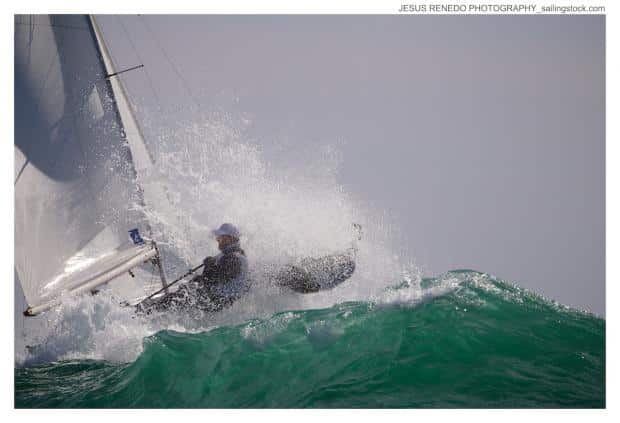**

**
Tell us about this photo.
I was following a group of 470s from the Italian team. They were lining up, in a sort of speed test, and I was following the one team (ITA 25: Francesco Falcetelli and Enrico Clementi) waiting for a big wave to splash the bow. A few seconds later the big wave came, and they took a big roller, in what was one of my favorite shots of the day. It makes a diagonal from left to right, taking you to the crews’ faces. Diagonals work very well in photography and also for composition, moving the main subject away from the center.
Looks like there were plenty of big waves there!
It was a typical winter cold front, blowing southwest then west and northwest and ended up with a big snowstorm that left the mountains covered with snow. But it was way stronger than any other this year. Palma Bay is open to the southwest, so we had a big swell, 25 knots, and the best sailors in the world training for the Arenal Training Camps, a warm up race two weeks before the World Cup event. So we had gold medalists, world champions in the hardest conditions, mastering boathandling. Also, this new Olympic period brings two new classes, the Nacra 17 and 49er FX , and a lot of crews are moving into them. So I was eager to shoot all those new boats, but I never dreamed of finding such conditions.
How did you get the photo?
It was quite hard, as both days I was driving the RIB and taking photos at the same time, and that was a bit risky, as the surf was up with big rollers. Every now and then I had the opportunity to shoot boats going through tips of big waves, keels in the air, and crews taking lots of water. There were many masts broken, and the coaches where very busy.
What camera did you use?
Canon EOS 1D MK IV + 500mm F/4
Palma is your home base?
Yes, I live in Palma. From March until May I am always here, as we have a lot of things going on: the Arenal Training Camps and ISAF World Cup, both Olympic classes events. And right after there’s Palmavela, the unofficial opening of the Med season for Maxis, TP52s, Soto 40s, and IRC and Monotype fleets. Apart from that I spend around one or two weeks away every month on average.
I’ve also seen some great shots of big boats from you (we featured a shot you took of an Open 60 in our September issue). Does the subject of your photography change your approach?
I enjoy shooting on board, and it is a bit difficult in dinghies. Also you depend more on weather conditions to get a sense of action when shooting big boats: They need a lot more wind. When working with big boats, the boat is more the protagonist; with dinghies, it is more the crew.
How did you get started in photography? What did you do for work before you became a photographer?
I sailed professionally as a crew first and skipper later, and I also owned a scuba diving center in Mallorca. I have been into photography for many years and have always had a camera with me, everywhere. I had a small dark room in my parents’ house, and in the beginning I did lots of black and white.
What do you do in your free time?
My favorite hobbies are sailing, trekking, and snow skiing … and laying down on my couch at home after an event watching TV!
Any advice for aspiring sailing photographers?
Passion—you gotta love it, it takes a lot of energy and time, and it is a very difficult market. Making a living is hard, and you need to be able to do other things before you can live only out of photography. But if you make it, it is the best job possible.
Visit Jesús Renedo’s website for more photos, and click here for more photos from Renedo and others at the ISAF Sailing World Cup.
Click here for more information on the ISAF Sailing World Cup in Palma.
Click here to find previous editions of Photo of the Month.









